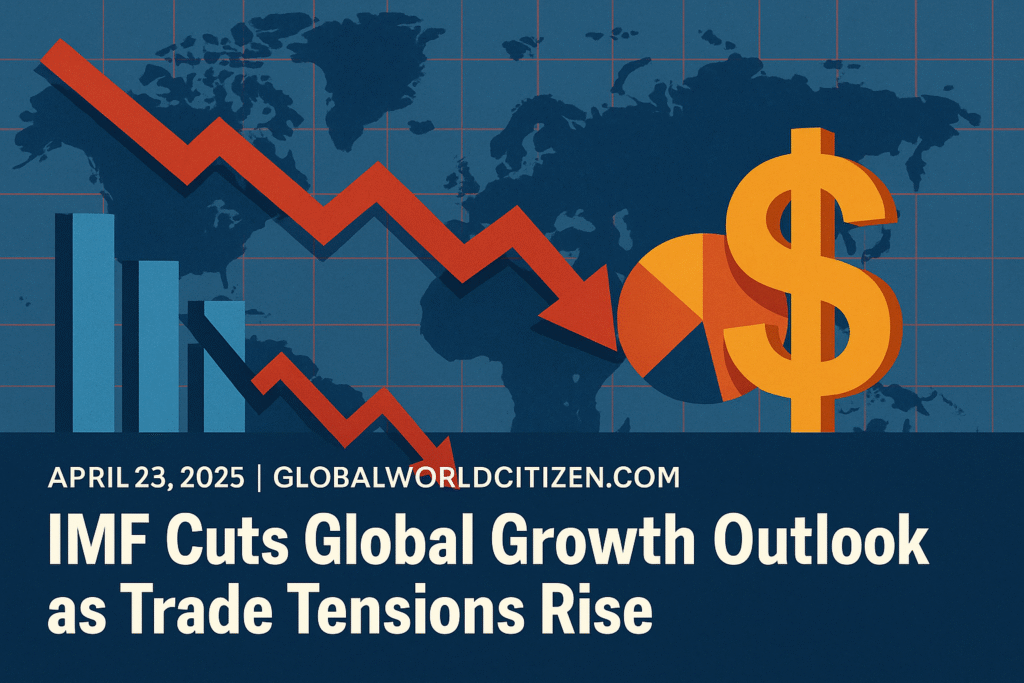Published Date: April 23, 2025 ✍️ Author: Global Desk – GlobalWorldCitizen.com 🌐 Source: GlobalWorldCitizen.com
The International Monetary Fund (IMF) has officially downgraded its global economic growth forecast, citing rising trade tensions, U.S. tariffs, and increasing policy uncertainty as key threats to global stability. In its newly released World Economic Outlook, the IMF predicts the global economy will grow just 2.8% in 2025, sharply down from its earlier 3.3% forecast. This marks the slowest global growth rate since the COVID-19 pandemic and one of the weakest periods since the 2008 financial crisis.
The forecast for 2026 has also been revised downward to 3%, highlighting growing concerns of a longer-term global economic slowdown.
 Global Slowdown: What’s Driving It?
Global Slowdown: What’s Driving It?
The IMF attributes much of the global economic deceleration to U.S. trade policy under President Donald Trump, whose sweeping tariffs have triggered ripple effects across international markets.
According to IMF Chief Economist Pierre-Olivier Gourinchas:
“The global economic system that has operated for the last 80 years is being reset. We are entering a period of higher uncertainty and economic fragmentation.”
 Key Factors:
Key Factors:
-
U.S. tariffs at record levels, causing both supply-side shocks (higher costs, reduced productivity) and demand-side damage (falling exports, declining global trade).
-
Investor confidence drops, with the S&P 500 down 11% since Q4 2024.
-
U.S. dollar weakens by 7% against global currencies.
 U.S. Economic Outlook: Slower Growth, Higher Inflation
U.S. Economic Outlook: Slower Growth, Higher Inflation
The IMF now estimates that U.S. GDP growth will slow to 1.8% in 2025—down from the previous 2.7%. Inflation is projected to hit 3%, 1 percentage point higher than earlier forecasts. Political instability, market volatility, and fears over the Federal Reserve’s independence are weighing heavily on investor sentiment.
 China’s Economy Under Pressure Despite Stimulus
China’s Economy Under Pressure Despite Stimulus
China’s projected GDP growth for both 2025 and 2026 has been reduced to 4%, amid:
-
Disrupted global supply chains
-
U.S. tariff impact
-
Domestic economic imbalances
Despite efforts to stimulate internal demand and offset the tariff burden, China’s recovery faces structural headwinds.
 Global Trade in Decline
Global Trade in Decline
The IMF has cut global trade growth forecasts by 1.5%, citing:
-
Protectionist policies
-
Geopolitical tensions
-
Non-tariff barriers
-
Disrupted supply chains
With world trade flows shrinking, global markets are more vulnerable than ever to cascading economic shocks.
 IMF Warns: Forecast May Be Too Optimistic
IMF Warns: Forecast May Be Too Optimistic
The IMF’s forecasts—usually compiled over two months—were condensed into just 10 days due to the urgency following Trump’s April 2 tariff escalation. Analysts warn that the IMF may still be underestimating the true scale of economic disruption.
“History suggests the real impact may be worse than forecast.”
— Bloomberg Economics Analysts
 GlobalWorldCitizen.com Insight: A Wake-Up Call for Economic Cooperation
GlobalWorldCitizen.com Insight: A Wake-Up Call for Economic Cooperation
At GlobalWorldCitizen.com, we believe this moment calls for bold leadership, transparent economic reform, and a renewed global cooperation strategy.


 Stay Informed. Stay Empowered.
Stay Informed. Stay Empowered.
Subscribe to GWC Premium for:
-
Weekly reports on global economic trends
-
Real-time updates on U.S.-China trade wars
-
Insightful breakdowns of investment risks and opportunities
-
Curated intelligence for global entrepreneurs, investors, and policy leaders


